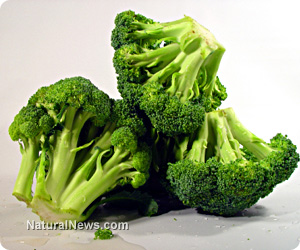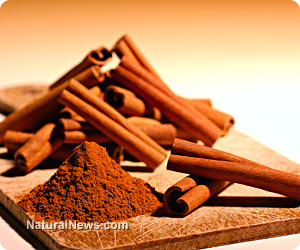Life Expert
Saturday, August 9, 2014
Saturday, July 26, 2014
Thursday, September 19, 2013
Scientists discover exact mechanism for how broccoli and crucifers fight deadly cancers
Scientists have been mounting evidence to support the cancer-fighting abilities associated with consuming broccoli and other members of the crucifer family for more than a decade. Past studies have shown that this super-food family directly influences the expression of more than 400 genes immediately after eating the tasty vegetables. Further research bodies have also shown that broccoli consumption can play an important role in lowering the risk of developing cardiovascular diseases, and yet to date, the precise metabolic pathway for disease prevention has largely been unknown.
A team of research scientists from Britain's Institute of Food Research have published the results of their work in the American Journal of Clinical Nutrition to explain how metabolic modifications brought about by consumption of high-glucoraphanin broccoli may be behind the suggested health benefits and cancer-fighting ability of the cruciferous vegetable family. Scientists noted that this study provides the first evidence from human studies for a possible mechanism behind the suggested ability of glucosinolates, including glucoraphanin found in broccoli, to reduce the risks of chronic diseases and cancers.
Broccoli and crucifer compounds rejuvenate critical mitochondrial function to prevent chronic illnesses
Researchers fed a special cultivar of broccoli, a combination of wild and commercially available broccoli that contains high levels of glucoraphanin, to nineteen volunteers each week for three months. They compared the first group to two other groups eating the same diet, except one consumed commercially available broccoli and the third ate none of the crucifer. The team observed that those eating the glucoraphanin-rich vegetable showed signs of an improved metabolism.The scientists determined that a compound commonly found in crucifers, known as sulforaphane, improved the chemical reactions inside mitochondria, the power source for our cellular machinery. The study found that glucoraphanin helped 'retune' metabolic processes in the cells that get disrupted as we age. Lead author, Dr. Richard Mithen commented, "We think this provides some evidence as to why people who eat diets rich in broccoli may keep in good health... mitochondria are really, really important, and when they start to go wrong it leads to many of the diseases of aging."
The nutritionists performing the study recommend eating broccoli two to three times a week. Other health-promoting members of the cruciferous vegetable family include Brussels sprouts, kale and cauliflower. Dr. Mithen concluded "We think it is significant because it shows in humans a measurable effect on our metabolism, which is central to our overall health and could explain the diverse range of beneficial effects many observational dietary studies have shown previously." It is important to note that while this study used a specially concentrated type of broccoli to produce the stated results, consumption of commercially available broccoli and crucifers have been shown to exhibit similar anti-cancer properties when eaten over a longer period of time.
Cinnamon levels up from common spice to 'super' health food
A team of scientists elevated the prized spice, cinnamon, from its culinary applications to a loftier stratum as a promising molecular weapon for combating chronic diseases. Researchers from various fields, including Kiram Panickar, Heping Cao, Bolin Qin and Richard A. Anderson, collaborated in making this significant breakthrough. The results revived ancient interest in the therapeutic benefits of common cinnamon, Cinnamomum verum or Cinnamomum zeylanicum, also known as the "true cinnamon," to modern genomic medicine. Compounds found in cinnamon revealed multiple utility in terms of enhancing the effects of insulin, its antioxidant function, efficacy against inflammation, and its neuroprotective benefits.
Cinnamon polyphenol extract (CPE) regulates a number of genes and exerts a significant influence on the metabolism of glucose. Various studies conducted on human subjects afflicted with metabolic syndrome, polycystic ovary syndrome and type 2 diabetes mellitus also showed the beneficial effects of whole cinnamon and its aqueous extract on the glucose, insulin, lipid profile and anti-oxidant status of the patients.
Experts also posited possible effects of cinnamon compounds on body composition, lean body mass and inflammatory response.
Cinnamon Extract Helps against Dyslipedemia
Patients with metabolic syndrome develop resistance to insulin action, which in turn causes dyslipedemia or abnormal level of lipids in the blood. In most cases, the problem is hyperlipedemia. Cinnamon presents a good potential in lowering lipid levels in both animal and human subjects.Cinnamon Extract Lowers Systolic Blood Pressure
Agents that are typically employed as an intervention for insulin resistance and/or lower circulating insulin concentration in the blood also tend to lower blood pressure. Such agents include nutrients, nutritional supplements, and drugs. Research conducted on spontaneously hypertensive rats fed with sucrose-containing diet showed that elevated systolic blood pressure (SBP) is lowered when the rats were given dietary cinnamon. This presents a promising development highlighting the efficacy of cinnamon not only for sucrose-induced high SBP but also for hypertension caused by genetic factors.Molecular Targets
Based on the aforementioned link between chronic diseases and genetic influences, research is now pursuing genomic targets for therapy. Quantitative research on polymerase chain reaction was performed to examine the effects of aqueous cinnamon extract on the expression of genes coding for the glucose transporter (GLUT) and anti-inflammatory tristetrapolin (TTP) families, components of the insulin signal transduction pathway, etc. So far, there are tell-tale signs that the medical hypotheses on selected targets are leaning towards positive results.Age-Old Super Spice
From its basic ancient uses as treatment for toothache, anti-halitosis or bad breath, medication for the nasty common cold and digestion aid, cinnamon has gone quite a long way. Recent studies also showed that even just the smell of cinnamon or chewing cinnamon gum improves brain function from memory to visual-motor speed, recognition, and attention and focus.In Closing: Cinnamon Now a Certified "Super" Food
It's no wonder that cinnamon is now a "super" spice being painstakingly developed through genomic medicine to neutralize stubborn chronic diseases that have plagued the modern world. There is voluminous research evidence for its medicinal value and health benefits. Cinnamon doesn't just spice up the gustatory sense. It spices up your health for a better life ahead.Disease prevention and other health benefits of parsley
Dr. Harold Gunatillake, an affiliate of the Fellowship of the Royal College of Surgeons, asserts that the herb, parsley, has more to offer than being a mere colorful trimming on the delectable dishes most often served in restaurants. Beyond its almost negligible size and its tasty green dynamic flavor, parsley has plenty to offer in terms of health benefits and disease prevention.
Most popular types of parsley
Two very well-known types of parsley are the curly parsley and the Italian flat leaf. The flat kind possesses a more aromatic scent and a less pungent flavor compared to the curly type. The curly type is preferred by people because of its decorative look that is great for use as garnishing. Another type of this herb, known as root or turnip-rooted parsley, is grown for its roots similar to a type of oyster plant or the weedy, biennial plant known as burdock. Root parsley is typically used in cooking within the regions of Central and Eastern Europe. It is used as a nibble or vegetable addition for stews, stocks, soups, sauces, and casserole dishes.Nutrition rating system
According to the food rating system, a typical serving of parsley contains vitamin K or potassium, vitamin C or ascorbic acid, vitamin A, folate, iron, and zero calories. A small stem of parsley has two uncommon elements that provide exceptional heath benefits. One is a volatile oil, specifically, myristicin, while the other component is made up of flavonoids.Prevention of illnesses and cell damage
In the course of animal researches, volatile oils have been proven to impede development of tumors specifically in the lung area. Myristicin was also proven to trigger glutathione-S-transferase, an enzyme that facilitates the attachment of the glutathione molecule to molecules that have gone through the oxidation process. The actions of volatile oils make these food components serve as neutralizers for certain types of carcinogenic substances. Luteolin, one of the flavonoids, has been proven to function as an antioxidant. It combines with very reactive molecules that carry oxygen or oxygen radicals. This combination helps in preventing cell damage. Parsley extracts were utilized in animal researches and were proven to help in improving the blood's antioxidant function.Conclusion
In summary, apart from these flavonoids and volatile oils, Dr. Gunatillake reports this herb as one of the best sources of essential nutrients. It contains folic acid, vitamin A or the anti-infective vitamin, and vitamin C which is useful in preventing illnesses. It helps in lowering the levels of free radicals and in maintaining the healthy function of the body's immune system. Parsley may also facilitate good appetite, improve the digestive process and urine production, diminish spasms, and increase menstrual flow.Health benefits of okra
Okra is available the entire year in the southern lands, but for Americans, it is only available during summer. The appearance of okra is comparable to that of a grooved pepper, and it belongs to the same genus as both cotton and hibiscus. Food experts said that the most likely origin of this vegetable is Africa, and it was transported from there to the United States about 300 years ago.
Unique Characteristics of Okra
Okra looks appealing with its tender leaves and fruit. But its most outstanding feature is the fruit's gelatinous and slimy juice that gets released and mixed into sauce or soup during cooking. That gelatinous, slimy juice is a favorite ingredient in soups and gumbos.But if the juice is not to your liking, you can try frying it quickly along with cornmeal on a saute pan. It is important that you take advantage of this wonderful fruit for all the health benefits that it can give.
Okra Health Trend
This vegetable is packed with fiber, which is good for cholesterol management. It has been found to contain folic acid and vitamin B6 with amounts equivalent to 1/10 of the recommended daily intake for Americans.Okra plant grows naturally in regions that have warmer climates. South China is one such region. Kantha Shelke, from the Institute of Food Technologists, said that okra was the vegetable served to Olympic athletes during the Beijing Olympics. She added, okra is also called "plant Viagra" in the US and "green panax" in Japan, due to the physiological effects it can bring. The okra fruit has been found to contain polysaccharides, food nutrients that can improve blood flow the way Viagra can.
Back here in the US, Americans are still in the adjustment period with regard to the use of okra. It is gaining popularity in some quarters but not with the mainstream American consumers. Shelke, a researcher on food trends, pointed out that okra chips are popular in vegetarian and Indian restaurants. Another vegetable researcher, Eugena Yoo of the New York City Green market, said that New Jersey foreign communities tend to favor okra over other vegetables for its purported health benefits.
The Nutrients Okra Contains
Okra contains vitamins, minerals and the antioxidants epicatechin, catechin, rutin, procyanidin B1 and B2 and quercetin. These antioxidants are capable of preventing damage to cells caused by environmental factors and stress.Okra's physiological effects are credited to the carbohydrates that it contains. According to Shelke, its physiological effects include the following:
- Anti-diabetic effect - the fiber in okra is able to slow down sugar absorption to the blood.
- Lipid-control effect - The soluble fibers of okra, called pectin, are able to lower blood cholesterol by 10%.
- Brain-function-improvement effect - Shelke reported that people in Southeast Asia, the Far East and the Middle East eat okra for the purpose of improving brain functions.
Conclusion
Though new in the medical arena, okra is gaining popularity fast. If anyone is suffering from diseases or needs nutritional supplementation, incorporating okra into the diet may just be one of the best steps to take.Five restaurant mistakes you should avoid
A recent article published in Health Magazine revealed some common restaurant mistakes that healthy people on a diet might make unconsciously, impeding their quest for weight loss. Listed here are 5 of the most common mistakes healthy people make.
Mistakes you didn't realize you did
Most dieters believe that if they use a smaller plate they'll be eating less so they lose weight and stay healthy.
One of the restaurant mistakes healthy people make is that they usually order salads.
Everybody loves steak.
Looks can be deceiving.
Another common mistake made is just ordering without asking questions.
These restaurant mistakes healthy people make are quite common and often times overlooked. For healthier eating, it is advisable to be mindful and to be inquisitive rather than relying on whatever is readily available.
Subscribe to:
Posts (Atom)





